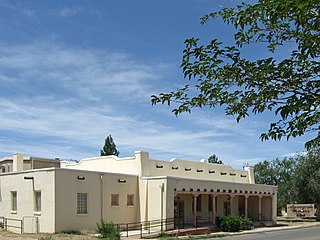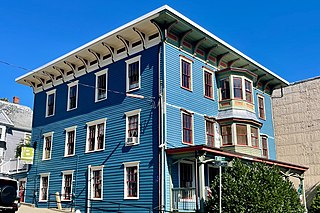
Hidalgo County is the southernmost county of the U.S. state of New Mexico. As of the 2020 census, the population was 4,178. The county seat and largest city is Lordsburg. A bill creating Hidalgo from the southern part of Grant County was passed on February 25, 1919, taking effect at the beginning of 1920. The county was named for the town north of Mexico City where the Treaty of Guadalupe Hidalgo was signed, which in turn was named for Miguel Hidalgo y Costilla, the priest who is known as the "Father of Mexican Independence." The county is located on the Mexico–United States border.

Lordsburg is a city in and the county seat of Hidalgo County, New Mexico, United States. Hidalgo County includes the southern "bootheel" of New Mexico, along the Arizona border. The population was 2,797 at the 2010 census, down from 3,379 in 2000.
State Road 80 (NM 80) is 32.416-mile-long (52.168 km) north–south state road in southwestern New Mexico, between the Arizona state line near Rodeo and Interstate 10 (I-10) at Road Forks. Lying entirely within Hidalgo County, New Mexico, it is the only section of the old U.S. Route 80 (US 80) in New Mexico which still retains its number. The route was re-designated NM 80 in 1989. This is the reason why NM 80 has an even number designation despite the highway being north/south. From the south, SR 80 acts as a continuation of NM 80 into Arizona.
Southwestern New Mexico is a region of the U.S. state of New Mexico commonly defined by Hidalgo County, Grant County, Catron County, Luna County, Doña Ana County, Sierra County, and Socorro County. Some important towns there are Lordsburg, Silver City, Deming, Las Cruces, Truth or Consequences, Socorro, Reserve, and Rodeo. Natural attractions there include White Sands National Park, the Organ Mountains, Bosque del Apache National Wildlife Refuge, and the Gila Wilderness surrounding the Gila Cliff Dwellings National Monument. Southwestern New Mexico is also home to both the Very Large Array and White Sands Missile Range containing the Trinity Site.

Shakespeare is a ghost town in Hidalgo County, New Mexico, United States. It is currently part of a privately owned ranch, sometimes open to tourists. The entire community was listed on the National Register of Historic Places in 1973.

Mesilla Plaza is the central plaza in the small town of Mesilla in far southern New Mexico. The plaza and a number of its surrounding buildings are a National Historic Landmark District, significant for its role in the transfers of power that brought first the original New Mexico Territory and later the Gadsden Purchase into United States control. The most notable building facing the plaza is the Basilica of San Albino, which has been on the plaza since its establishment in 1851. The plaza was declared a National Historic Landmark in 1961.

The Colfax County Courthouse in Springer, New Mexico, is a building on the National Register of Historic Places that was used as a seat of county government for Colfax County, New Mexico from 1881 until 1897. The building is located at 614 Maxwell Avenue, Springer, NM 87747, and today it houses a museum devoted to the Santa Fe Trail. The building was placed on the National Register in 1987.

This is a list of the National Register of Historic Places listings in Socorro County, New Mexico.

This is a list of the National Register of Historic Places listings in Hidalgo County, New Mexico.

Animas is an unincorporated community and census-designated place (CDP) in west-central Hidalgo County, New Mexico, United States, in the southwestern corner of the state. As of the 2010 census it had a population of 237.

The Rundel Memorial Building is a historic library building located at Rochester in Monroe County, New York. It is the original downtown site of the Rochester Public Library, and along with the Bausch & Lomb Library Building directly across the street, serves as the Central Library of Rochester and Monroe County. It is framed in reinforced concrete and faced in smooth Indiana limestone. It consists of three main floors, a mezzanine, two underground levels, a catwalk level above the river, and a penthouse area for equipment. It was constructed between 1934 and 1936, and represents an integration of Beaux-Arts planning and massing with Art Deco detailing and stylization. The building is sited along the east side of the Genesee River directly above the Johnson and Seymour millrace and Rochester Subway. The building was built in part with monies from the estate of Morton W. Rundel and with a grant from the Public Works Administration.

This is a list of the National Register of Historic Places listings in Hidalgo County, Texas

The Clayton Public Library, at 116 Walnut St. in Clayton, New Mexico, was built in 1939 as a New Deal construction work. It was designed by Willard C. Kruger in Pueblo Revival architecture. It is now known as the D.D. Monroe Civic Building. It has served historically as a library, as a meeting hall, and as a clubhouse.

The Hidalgo County Courthouse, located at 300 S. Shakespeare St. in Lordsburg, is the county courthouse serving Hidalgo County, New Mexico. The two-story Neoclassical building, designed by architects Thorman & Frazier, was constructed in 1926. The red brick building features concrete spandrels between the first- and second-story windows and a concrete band at the top of the second-story windows. The entrance is topped by a classical pediment and flanked by pilasters with floral medallions. A metal cornice and crested parapet wrap around the building's roof line.
Archeological Site No. LA 54050 is a prehistoric archaeological site in Hidalgo County, New Mexico. The Animas phase site was inhabited from roughly 1200 to 1350 A.D. Its principal feature is a 1-metre tall adobe mound with about 50 rooms. Another adobe block to the south of the main mound may contain another 50 rooms, though it has not been fully investigated. A lithic scatter is located to the west of the main site. Artifacts recovered from the site include ceramics, cobbles, and projectile points.
Archeological Site No. LA 54042 is a prehistoric archaeological site in Hidalgo County, New Mexico. The site was inhabited during the Animas phase ; some artifacts may also date from the Salado phase A small adobe structure with one to three rooms sits on the east side of the site; it is surrounded by scattered cobbles and ceramics. The structure's small size suggests that it was used as some sort of temporary building, possibly as a field house. The remainder of the site consists of dispersed lithic shards with a relatively low density.

The Alamogordo Woman's Club is a women's club based in New Mexico. It operates under the auspices of the New Mexico Federation of Women's Clubs (NMFWC). The club was created to provide Alamogordo women a way to serve their community. Of note was the Alamogordo Woman's Club's providing books to school libraries.
Lordsburg—Hidalgo County, Lordsburg, Hidalgo County, or Lordsburg Hidalgo County may refer to:

The Boonton Public Library, also known as the Holmes Library, is located at 619 Main Street in the town of Boonton in Morris County, New Jersey. Built c. 1849, the Greek Revival building was purchased by James Holmes in 1856 and became the public library in 1893. It was added to the National Register of Historic Places on November 13, 1972, for its significance in communications, education, and social history. It was added as a contributing property to the Boonton Historic District on September 29, 1980.














